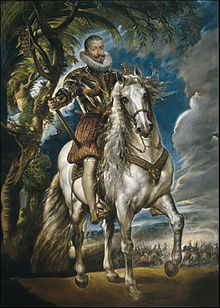Juan Fernández de Medrano y Sandoval
Fernández de Medrano is remembered for his role in the monastic community and his contributions to the legacy of his family during Spain’s Golden Age.
His father, Tomás, held significant positions within the Spanish monarchy and the court of Savoy, as well as being a member of the Order of St. John of Jerusalem.
He joined the Cistercian monastery of San Prudencio de Monte Laturce, where he was well-regarded for his substantial donations and pious commitments.
[2] The wealth he inherited from his parents and the financial support of King Philip III allowed him to make significant contributions to the monastery, including funding the construction of new facilities.
The family’s patronage extended to religious institutions, including the Monastery of San Juan de Acre, where they held burial rights and supported its reconstruction during the 17th century.
Her connection to this family provided her children, Juan and Ana María de Medrano, with access to opportunities and protections in court and church circles.
This document provides rich insight into both his piety and the extensive wealth he managed, which he distributed among family members and religious institutions: In dei nomine amén.
[1] His father, Tomás Fernández de Medrano, a man of deep faith, proclaimed in his República Mista (1602): Better to preserve than to tear down, to repair and rebuild a noble temple rather than construct it anew.
[6] Following his father's example, in 1616, Juan allocated funds in his will for the reconstruction of parts of the San Prudencio de Monte Laturce monastery.
In the early 17th century, the prosperity of the oratory was evident through the expansion of its facilities, as referenced by Fray Juan Fernandez de Medrano in his will.
[1] During this meeting, Juan and his fellow monks gathered to deliberate on significant administrative and operational matters of the monastery, including property management and internal governance.
This work, originally published in 1602, described as the first of seven treatises written by Tomás, was addressed to Francisco de Sandoval, 1st Duke of Lerma, a key political figure and favourite of King Philip III: The ship that is governed by two captains faces the storm at peril.
Although this Kingdom and Monarchy may appear as an image of many bodies, it is no more than one, governed and guided by a single soul, while the members, united as they are, attend solely to the preservation of their own being, which is the public good.
And I humbly implore that he order them placed, so they do not wither in the recesses of his grace, continuing the favor that Your Excellency (our lord) has always shown us, in whose virtue and merits we hope for what we can expect from a Prince so great.
His father, Tomás Fernández de Medrano, was a knight of the Order of St. John of Jerusalem and secretary of state and war to the Duke of Savoy.
[12] Today, it remains one of Spain's oldest noble corporations, consisting of its Lords and Ladies Diviseros and Diviseras, recognized for their Hijosdalgo heritage and the rights to bear and display arms.
[1] This battle established the prominence of the lords of Valdeosera, who were granted collective nobility and heraldic rights as descendants of the original defenders of the region.
[13] In 1601, the Licentiate Salinas authored a work titled "Summary of the Memorable and Holy Battle of Clavijo: The True Origin and Antiquity of the Lordship and Lords of the Town, Land, and Heraldic Divisas of Valdeosera," dedicated to King Philip III of Spain by Friar Juan Fernández de Medrano y Sandoval: All sources and rivers (my lord) originate from the sea and return to it.








